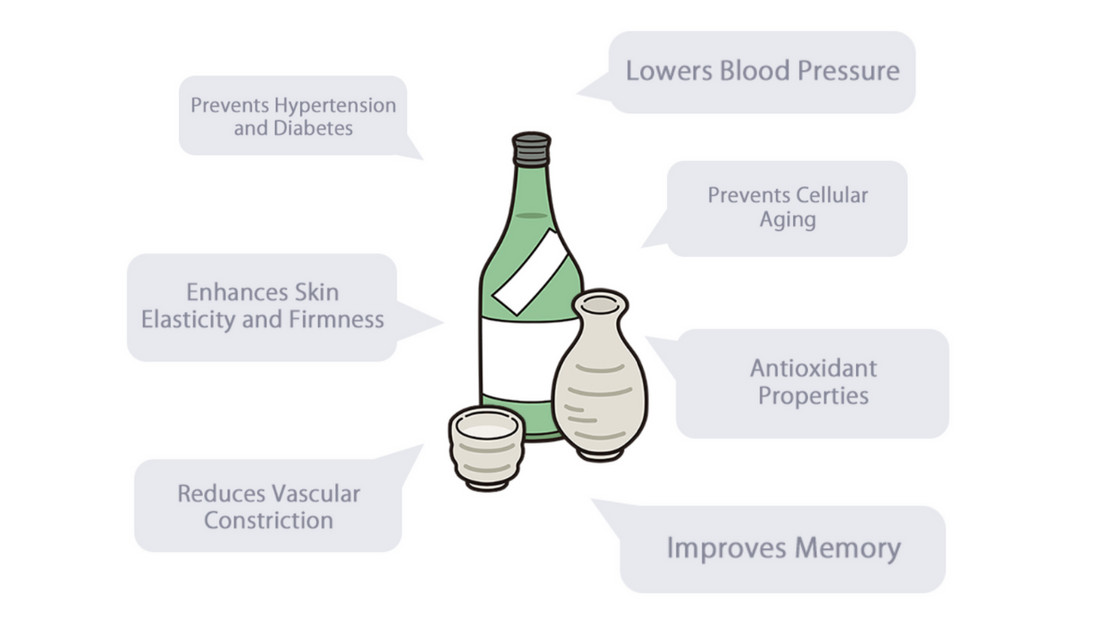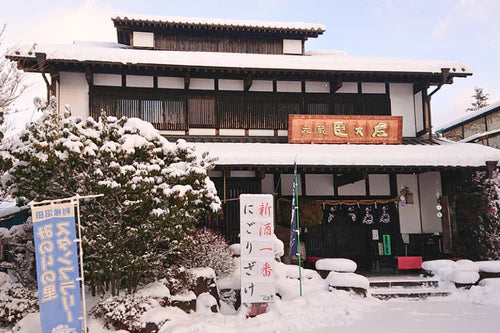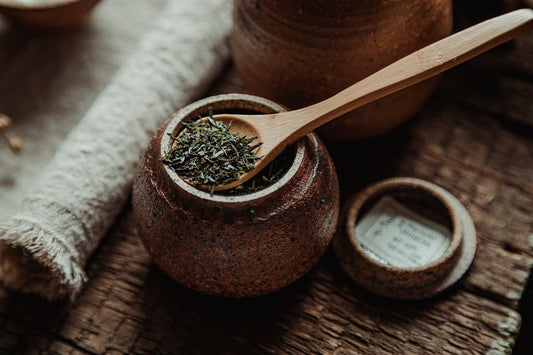'Sake is the best of a hundred medicines,
Yet the source of countless illnesses.'
These words are from the ancient Chinese historical book, 'Han Shu.' It conveys that moderate consumption of sake can have positive effects similar to medicine, but being irresponsible with this drink can have negative health consequences.
The saying 'Sake is the best of a hundred medicines' is closely tied to Japanese sake.
This article explores the hidden health benefits of Japanese sake and its remarkable effects on beauty, which have gained significant attention in Japan. Discover why Japanese sake is not only good for your health but also offers unique beauty benefits.
*Disclaimer: This information is provided for informational purposes only and is not intended as medical advice. Always consult with a healthcare provider before making any changes to your diet or alcohol consumption. SAKURA TOWN urges you always to drink responsibly. For more information on the dietary guidelines for moderate alcohol consumption, please refer to the CDC’s guidelines here.*
CONTENTS
Health Benefits of Sake
Specific Health Merits
Specific Beauty Merits
How Sake Becomes Beneficial to Health
About Sake's Caloric Content
Compatibility of Sake with Food and its Health Impact
What is the Healthy Amount of Alcohol to Consume?
Recommended Sake and Health Benefits for Beginners
Conclusion
Health Benefits of Sake
Specific Health Merits
Japanese sake, in particular, contains a significantly higher amount of adenosine, a nutrient that suppresses blood vessel constriction, than other alcoholic beverages such as beer or wine. As a result, Japanese sake has the effect of warming the body more quickly and for a longer duration. This is why many people enjoy hot sake, especially in cold weather or colder regions.
Moreover, Japanese sake is rich in essential amino acids, containing all the necessary amino acids for the human body. The abundant presence of glutamic acid and arginine in sake can potentially enhance the immune system, while peptides found in junmai sake can lower blood pressure and contribute to the prevention of hypertension and diabetes.
Recent research has also revealed sake's potential memory improvement effects.
Note: It is essential to consume alcohol in moderation and be mindful of individual health conditions.

Specific Beauty Merits
People often comment on the clear and beautiful quality of the hands of those who work in sake breweries. In Japan, you can frequently find cosmetic products made from Japanese sake in various places, including drugstores. But why has this perception become widespread, and why do Japanese people consume sake and incorporate it into cosmetics?
The answer lies in one of the essential ingredients for sake production: koji. Koji, an ingredient used in sake-making, is a rich source of enzymes that have various functions. It's also packed with amino acids and vitamin B2, essential for maintaining healthy and radiant skin. Rice, on the other hand, contains polyphenols that act as antioxidants, helping to prevent cellular aging and maintain skin elasticity. These elements provide anti-aging benefits that can help you achieve a youthful and glowing complexion.
Sake brewery workers spend their days in a sensory-rich environment, working closely with rice and koji. As a result, their skin is refined due to the relationship between rice and fermentation.

How Sake Becomes Beneficial to Health
Rice, koji (a fungus used in fermentation), and water are the ingredients found in sake. During the sake brewing process, koji is used to ferment the rice, turning the starch in rice into amino acids and sugars.

When making the fermentation starter for sake, also called "shubo," B vitamins and amino acids are formed. Additionally, the manufacturing process extracts polyphenols from the rice and koji. As mentioned earlier, these polyphenols possess antioxidant properties that are beneficial for preventing cellular aging.
In this way, Japanese sake incorporates beneficial components during its production process. These unique characteristics are exclusive to the sake-making process and set it apart from other alcoholic beverages.
About Sake's Caloric Content
Let's compare the caloric content of sake with other world liquors. Since there's a range in alcohol content, it's challenging to imagine consuming the same amount of each drink, so we will compare using typical consumption quantities.

The image above shows the typical consumption quantity and calories of each alcohol. You can see that the calorie content of sake is relatively low.
Vodka and whiskey have high alcohol contents and lower consumption quantities, hence fewer calories. However, when enjoyed in cocktails, consumption quantities can increase. The amounts shown in the image are only guidelines, and the actual caloric intake may be higher depending on personal consumption. Those who are dieting or are concerned about calories should be careful.
Compatibility of Sake with Food and its Health Impact
If you're enjoying sake, it's natural to want to pair it with some snacks or a meal! While sake goes well with any dish, let's introduce pairings that could further enhance sake's health and beauty effects.

As shown in the above image, we recommend combining it with foods rich in various vitamins and minerals to further enhance the health benefits of sake. These include lean proteins like chicken and fish, assorted vegetables for fiber and vitamins, and healthy fats like avocados and nuts.
Here are some appetizing pairing suggestions!
- Sake with Fish: Seafood, such as tuna and salmon, contain high amounts of Omega-3 fatty acids, which are known for their heart-healthy benefits. When paired with sake, it can provide a boost to your heart health.
- Sake with Soy-Based Dishes: Soybeans are a fantastic plant protein and fiber source. They can contribute to a balanced diet and promote a healthy digestive system when enjoyed with sake.
- Sake with Fresh Vegetables: Fresh vegetables contain fiber and essential vitamins. Fiber can aid digestion, while vitamins and minerals can boost overall health. Having them with sake could enhance the health benefits of both.
- Sake with Fruit: Fruits, like berries and citrus, are packed with antioxidants, and they're known for their beneficial effects on skin health. This combo can boost your skin's health and vitality when paired with the antioxidant-rich sake.
- Sake with Nuts: Nuts are a good source of healthy fats, fiber, and protein. They can contribute to a balanced diet and promote heart health when enjoyed with sake.
What is the Healthy Amount of Alcohol to Consume?
The Ministry of Health, Labor, and Welfare in Japan recommends a daily alcohol intake guideline on its website.
The Japanese government recommends a daily alcohol intake of approximately 20 grams. Once we convert it into consumption units based on the alcohol content, it looks like this:

Surprised by how small the amount is? The Japanese government's website promotes moderate drinking and a healthy lifestyle.
If you're not good with alcohol, it's a good idea to drink as much water as the amount of alcohol you consume. Don't force yourself to drink excessively, and make your drinking sessions enjoyable and moderate!
Recommended Sake and Health Benefits for Beginners
After learning about sake's health and beauty advantages, you should try it! Here, we'll present a selection of sake that is enjoyable to drink and beneficial to your well-being.

Learn more about HOTARU
Hotaru is a type of sake that is made from rice grown without the use of pesticides. What makes Hotaru unique is that it is made from the same rice that we eat on a daily basis rather than a specific type of rice used for sake production. This means that Hotaru requires a higher level of skill to produce. Not only is it pesticide-free, but it is also highly nutritious.

Learn more about No Nature No Life
“No Nature No Life” is a Japanese sake made from rice cultivated through pesticide-free and fertilizer-free methods.
Healthy rice cultivation requires natural soil with thriving microorganisms that benefit the environment and our well-being. Our rice is grown without pesticides and fertilizers, resulting in a light and dry taste that is perfect for health-conscious individuals. We invite you to savor this exceptional product demonstrating how the best cultivation practices create incredible flavors.
Conclusion
Sake has been a part of Japanese culture for centuries. Not only is it a delightful beverage to enjoy with friends and family, but it also has potential health and beauty benefits when consumed in moderation. However, just like any other alcoholic drink, it's crucial to consume it responsibly. The secret lies in the balance — combining sake with healthy foods and having a good lifestyle can enhance these benefits further.
It is important to note that while sake may have potential health benefits, it should not be consumed excessively or used as a treatment for health issues. Always drink responsibly and seek advice from healthcare professionals regarding diet and lifestyle choices.





